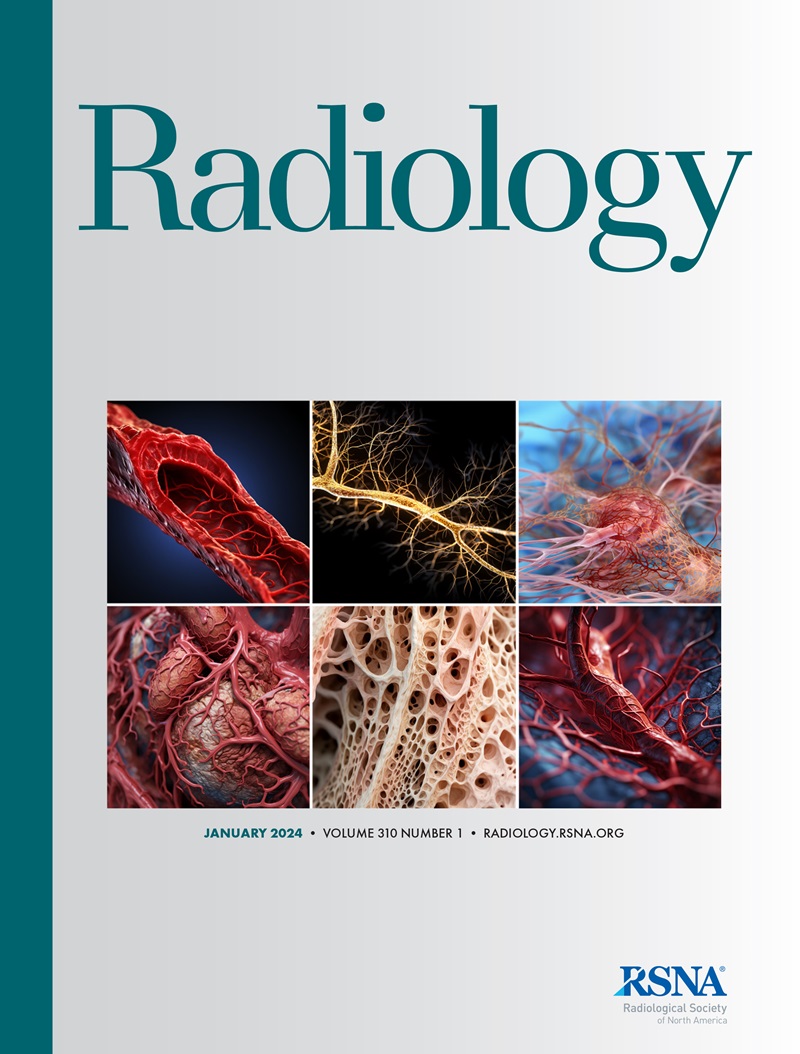求助PDF
{"title":"使用心脏CT和MRI数据的机器学习模型预测阻塞性冠状动脉疾病的心血管事件。","authors":"Théo Pezel, Solenn Toupin, Valérie Bousson, Kenza Hamzi, Thomas Hovasse, Thierry Lefevre, Bernard Chevalier, Thierry Unterseeh, Francesca Sanguineti, Stéphane Champagne, Hakim Benamer, Antoinette Neylon, Mariama Akodad, Tania Ah-Sing, Lounis Hamzi, Trecy Gonçalves, Antoine Lequipar, Emmanuel Gall, Alexandre Unger, Jean Guillaume Dillinger, Patrick Henry, Olivier Vignaux, Marc Sirol, Philippe Garot, Jérôme Garot","doi":"10.1148/radiol.233030","DOIUrl":null,"url":null,"abstract":"<p><p>Background Multimodality imaging is essential for personalized prognostic stratification in suspected coronary artery disease (CAD). Machine learning (ML) methods can help address this complexity by incorporating a broader spectrum of variables. Purpose To investigate the performance of an ML model that uses both stress cardiac MRI and coronary CT angiography (CCTA) data to predict major adverse cardiovascular events (MACE) in patients with newly diagnosed CAD. Materials and Methods This retrospective study included consecutive symptomatic patients without known CAD referred for CCTA between December 2008 and January 2020. Patients with obstructive CAD (at least one ≥50% stenosis at CCTA) underwent stress cardiac MRI for functional assessment. Eighteen clinical, two electrocardiogram, nine CCTA, and 12 cardiac MRI parameters were evaluated as inputs for the ML model, which involved automated feature selection with the least absolute shrinkage and selection operator algorithm and model building with an XGBoost algorithm. The primary outcome was MACE, defined as a composite of cardiovascular death and nonfatal myocardial infarction. External testing was performed using two independent datasets. Performance was compared between the ML model and existing scores and other approaches using the area under the receiver operating characteristic curve (AUC). Results Of 2210 patients who completed cardiac MRI, 2038 (mean age, 70 years ± 12 [SD]; 1091 [53.5%] female participants) completed follow-up (median duration, 7 years [IQR, 6-9 years]); 281 experienced MACE (13.8%). The ML model exhibited a higher AUC (0.86) for MACE prediction than the European Society of Cardiology score (0.55), QRISK3 score (0.60), Framingham Risk Score (0.50), segment involvement score (0.71), CCTA data alone (0.76), or stress cardiac MRI data alone (0.83) (<i>P</i> value range, <.001 to .004). The ML model also exhibited good performance in the two external validation datasets (AUC, 0.84 and 0.92). Conclusion An ML model including both CCTA and stress cardiac MRI data demonstrated better performance in predicting MACE than traditional methods and existing scores in patients with newly diagnosed CAD. © RSNA, 2025 <i>Supplemental material is available for this article.</i></p>","PeriodicalId":20896,"journal":{"name":"Radiology","volume":"314 1","pages":"e233030"},"PeriodicalIF":12.1000,"publicationDate":"2025-01-01","publicationTypes":"Journal Article","fieldsOfStudy":null,"isOpenAccess":false,"openAccessPdf":"","citationCount":"0","resultStr":"{\"title\":\"A Machine Learning Model Using Cardiac CT and MRI Data Predicts Cardiovascular Events in Obstructive Coronary Artery Disease.\",\"authors\":\"Théo Pezel, Solenn Toupin, Valérie Bousson, Kenza Hamzi, Thomas Hovasse, Thierry Lefevre, Bernard Chevalier, Thierry Unterseeh, Francesca Sanguineti, Stéphane Champagne, Hakim Benamer, Antoinette Neylon, Mariama Akodad, Tania Ah-Sing, Lounis Hamzi, Trecy Gonçalves, Antoine Lequipar, Emmanuel Gall, Alexandre Unger, Jean Guillaume Dillinger, Patrick Henry, Olivier Vignaux, Marc Sirol, Philippe Garot, Jérôme Garot\",\"doi\":\"10.1148/radiol.233030\",\"DOIUrl\":null,\"url\":null,\"abstract\":\"<p><p>Background Multimodality imaging is essential for personalized prognostic stratification in suspected coronary artery disease (CAD). Machine learning (ML) methods can help address this complexity by incorporating a broader spectrum of variables. Purpose To investigate the performance of an ML model that uses both stress cardiac MRI and coronary CT angiography (CCTA) data to predict major adverse cardiovascular events (MACE) in patients with newly diagnosed CAD. Materials and Methods This retrospective study included consecutive symptomatic patients without known CAD referred for CCTA between December 2008 and January 2020. Patients with obstructive CAD (at least one ≥50% stenosis at CCTA) underwent stress cardiac MRI for functional assessment. Eighteen clinical, two electrocardiogram, nine CCTA, and 12 cardiac MRI parameters were evaluated as inputs for the ML model, which involved automated feature selection with the least absolute shrinkage and selection operator algorithm and model building with an XGBoost algorithm. The primary outcome was MACE, defined as a composite of cardiovascular death and nonfatal myocardial infarction. External testing was performed using two independent datasets. Performance was compared between the ML model and existing scores and other approaches using the area under the receiver operating characteristic curve (AUC). Results Of 2210 patients who completed cardiac MRI, 2038 (mean age, 70 years ± 12 [SD]; 1091 [53.5%] female participants) completed follow-up (median duration, 7 years [IQR, 6-9 years]); 281 experienced MACE (13.8%). The ML model exhibited a higher AUC (0.86) for MACE prediction than the European Society of Cardiology score (0.55), QRISK3 score (0.60), Framingham Risk Score (0.50), segment involvement score (0.71), CCTA data alone (0.76), or stress cardiac MRI data alone (0.83) (<i>P</i> value range, <.001 to .004). The ML model also exhibited good performance in the two external validation datasets (AUC, 0.84 and 0.92). Conclusion An ML model including both CCTA and stress cardiac MRI data demonstrated better performance in predicting MACE than traditional methods and existing scores in patients with newly diagnosed CAD. © RSNA, 2025 <i>Supplemental material is available for this article.</i></p>\",\"PeriodicalId\":20896,\"journal\":{\"name\":\"Radiology\",\"volume\":\"314 1\",\"pages\":\"e233030\"},\"PeriodicalIF\":12.1000,\"publicationDate\":\"2025-01-01\",\"publicationTypes\":\"Journal Article\",\"fieldsOfStudy\":null,\"isOpenAccess\":false,\"openAccessPdf\":\"\",\"citationCount\":\"0\",\"resultStr\":null,\"platform\":\"Semanticscholar\",\"paperid\":null,\"PeriodicalName\":\"Radiology\",\"FirstCategoryId\":\"3\",\"ListUrlMain\":\"https://doi.org/10.1148/radiol.233030\",\"RegionNum\":1,\"RegionCategory\":\"医学\",\"ArticlePicture\":[],\"TitleCN\":null,\"AbstractTextCN\":null,\"PMCID\":null,\"EPubDate\":\"\",\"PubModel\":\"\",\"JCR\":\"Q1\",\"JCRName\":\"RADIOLOGY, NUCLEAR MEDICINE & MEDICAL IMAGING\",\"Score\":null,\"Total\":0}","platform":"Semanticscholar","paperid":null,"PeriodicalName":"Radiology","FirstCategoryId":"3","ListUrlMain":"https://doi.org/10.1148/radiol.233030","RegionNum":1,"RegionCategory":"医学","ArticlePicture":[],"TitleCN":null,"AbstractTextCN":null,"PMCID":null,"EPubDate":"","PubModel":"","JCR":"Q1","JCRName":"RADIOLOGY, NUCLEAR MEDICINE & MEDICAL IMAGING","Score":null,"Total":0}
引用次数: 0
引用
批量引用


